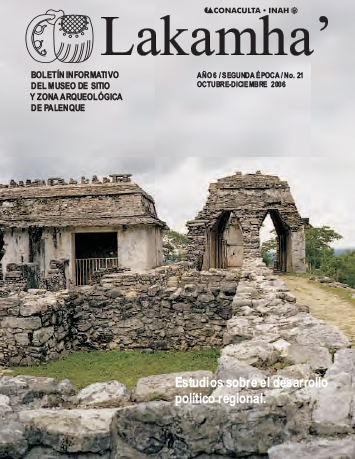Published 2022-12-02
Keywords
- Chinikihá,
- Palenque
Copyright (c) 2007 Instituto Nacional de Antropología e Historia

This work is licensed under a Creative Commons Attribution-NonCommercial 4.0 International License.
How to Cite
Proyecto Arqueológico Chinikihá. (2022). Lakamha’, 21, 3-7. https://revistas.inah.gob.mx/index.php/lakamha/article/view/18697
Abstract
No se cuenta con resumen.
Downloads
Download data is not yet available.
References
- Anaya, Armando (2002) Pomoná Kingdom and its Hinterland. Reporte entregado a Famsi. http://www.famsi.org/reports/00082/index.html.
- Berlin, Heinrich (1958) El glifo emblema en las inscripciones mayas. Journal de la Societé de Américanistes 47:111-19.
- Grave Tirado, Luis Alfonso (1996) Patrón de Asentamiento en la Región de Palenque, Chiapas. Tesis de Licenciatura, Escuela Nacional de Antropología e Historia, México.
- Grube, Nikolai y Simon Martin (1998) “Política Clásica Maya dentro de una tradición mesoamericana: un modelo geográfico de organización política hegemónica”. En Modelos de entidades políticas Mayas. Silvia Trejo ed. PP 131-146. INAH México.
- Houston, Stephen D. (1993) Hieroglyphics and History at Dos Pilas: Dynastic Politics of the Classic Maya. University of Texas Press: Austin.
- Marcus, Joyce (1976) Emblem and State in the Classic Maya Lowlands. Dumbarton Oaks Research Library and Collection: Washington D.C.
- Martin, Simon y Nikolai Grube (1995) “Maya Superstates”. Archaeology 48 6:41-43. 2000 Chronicle of the Maya Kings and Queens. Deciphering the Dynasties of the Ancient Maya. Thames and Hudson. Nueva York.
- Mathews, Peter (1991) Classic Maya Emblem Glyphs. In Classic Maya Political History. Hieroglyphic and Archaeological Evidence, edited by T.P. Culbert, pp.19-29. Cambridge University Press. 2001 The Dates of Toniná and a dark horse in its history. En The PARI Journal. Vol.II, No.1 Invierno 2001. Pre-Columbian Art Research Institute. San Francisco.
- Stuart, David (2003) http://www.mesoweb.com/reports/chinikiha.html

